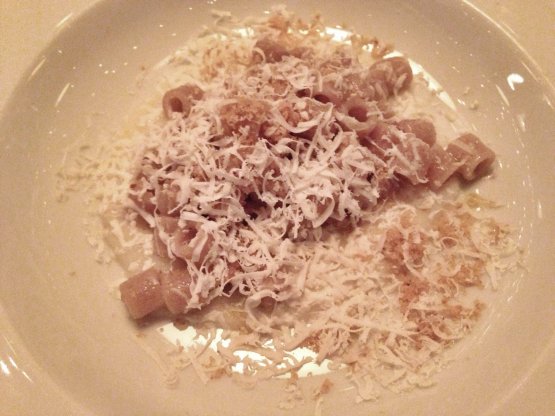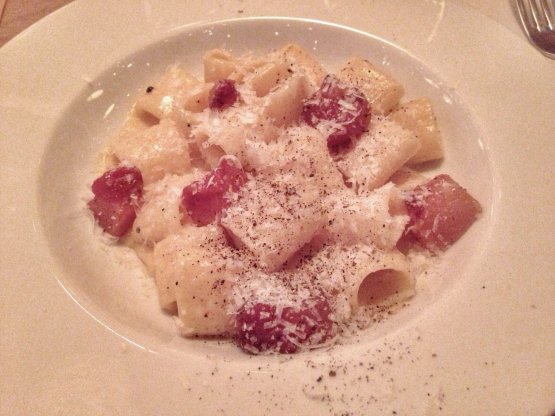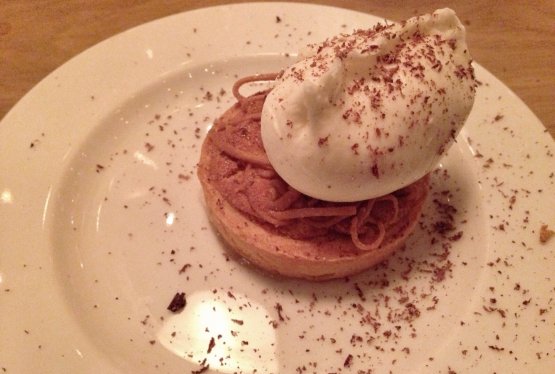A sold-out restaurant, not a single spare chair. A menu entirely dedicated to pasta. Paris enthusiastically welcomed the event organised at Quindici, a restaurant inside Beaugrenelle (a shopping centre in the 15th arrondissement), characterised by large windows beautifully overlooking the Seine.
In the leaflet produced by Quindici, presenting the event, some people who were crucial for its creation were thanked: first of all Filippo Giarolo, for his mad ideas. The Italian food dealer is a point of reference in Paris’ restaurant scene, as he’s capable of supplying selected products of the highest quality. Then there’s Paolo Marchi of Identità Golose, who enthusiastically said yes, joining this gourmet project. And also Riccardo Felicetti, who offered his pasta for the good – literally – turnout of the event.

Spelt ditalini, cauliflower, anchovies from Mazara, raisins, pine nuts, ricotta salata: Fabrizio Ferrara’s delicious dish
Paris, France and pasta. What is the relationship, the perception, the idea that the French have today of our pasta? We asked this first of all to
Julien Cohen, who’s the owner and manager of
Quindici, and five more Italian restaurants in Paris: «What the French look for in pasta is a truly Italian interpretation. Too often pasta is presented here without its authentic character, which we’ve been trying to put in our offer for the past fifteen years. As for me, the key words when it comes to pasta are “simplicity” and “tradition”. What the Parisian pasta-enthusiasts look for is this: attention to raw materials and diversity with regards to French cuisine, which is always very complex, articulated.»
Julien Mercier, the chef of the restaurant inside luxury hotel Molitor, the only French chef among those invited to the "A tutta pasta" dinner, has a similar point of view. When we ask him what he thinks about Italian cuisine he says: «it is a sunny and simple cuisine». And while this perhaps is a rather partial view, Mercier further explains when speaking about pasta and telling about the evolution of its perception in France: «When I started this profession, twenty-five years ago, people didn’t have much consideration for pasta, but this happened because we had very few brands here, and of bad quality. This has been changing over the years, products are better distributed and today many of us think that we can use pasta in gourmet restaurants.»

Luciano Monosilio’s famous Carbonara
’s dish
Linguine with clams and grilled turbot, was clearly a French dish. Pasta had a supporting role. Something which, as
Luciano Monosilio - chef at
Pipero al Rex who was in Paris to present his very famous and delicious
Carbonara, stressed – in Italian gastronomy does not happen, thanks also to
Davide Scabin: «I’d say that since the beginning of this millennium it is thanks to
Davide’s work in particular that signature cuisine is once again giving a main role to pasta, especially dry pasta. But I also think of
Enrico Crippa: when I was working at
Piazza Duomo the chef had designed a menu entirely based on pasta, yet in each dish it was the protagonist, while the seasonings, meat, and fish, were at its service.»
It is also interesting to hear the point of view of
Fabrizio Ferrara, chef and patron at
Caffè dei Cioppi in Paris. First of all, because his dish,
Spelt ditalini, cauliflower, anchovies from Mazara, raisins, pine nuts and ricotta salata, was perhaps the most seductive in the entire evening, perfectly balanced, embracing, full of aroma thanks both to the choice of the ingredients and to the extraordinary quality of
Felicetti’s Ditalini. For him «pasta has finally entered the gourmet restaurant offer in France too. Many chefs in the bistronomy scene, in Paris, use it to create original dishes.»
Ferrara also agrees that much depends on the quality of raw materials: «The great quality of pasta that can be found today has helped these chefs to understand its importance and to interpret its flavour.»

Tagliatella, fresh burrata, lemon-aromatised chocolate from Modica: a tasty creation by Giovanni Fausto Bertolini
For sure, the take on the main protagonist of the event given by pastry chef
Giovanni Fausto Bertolini, from
La casa del dolce in Verona, was very original. He presented a traditional cake from his land, a
Tagliatelle tartelette, on which, however, he placed some fresh burrata, and sprinkled some lemon-aromatised chocolate from Modica. A pairing that could have seemed daring, but in fact turned out to be immediate, easy and enjoyable, also thanks to the creaminess of the burrata, prepared on location by the dairy master of
Ottanta, a small business founded by Apulian
Sara Lacomba, who produces traditional mozzarella, burrata and ricotta using strictly organic, French milk. A cake that was both traditional and creative, and thus perfect to end the evening at
Quindici in Paris.